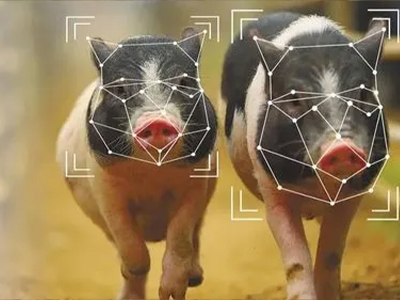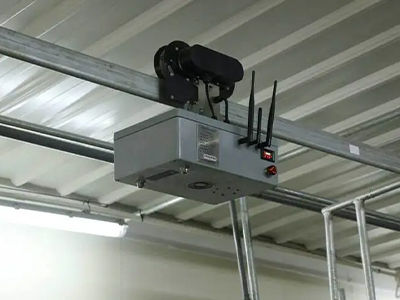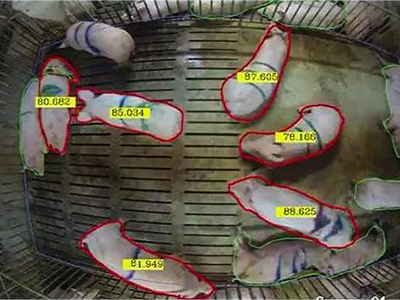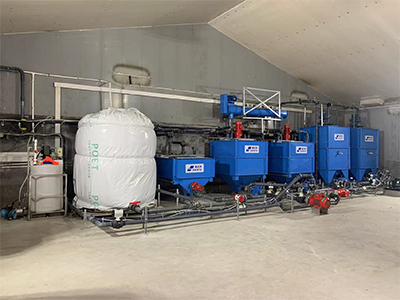Nowadays, the level of scientific and technological development is changing with each passing day, and the pig farming industry is not far behind. Next, let us approach the intelligent pig farm and take a look at these technologies.
AI pig face recognition
We must track and record the weight, food intake and other data of each piglet in order to judge its growth status. However, if we only rely on the naked eye of the breeder, it is almost impossible to distinguish hundreds or thousands of pigs. of pigs, therefore identification of each pig is required.
In the past pig raising process, pig ears were usually marked, but this method required manual recording of all data, which was very inefficient and error-prone.
In recent years, with the development of deep learning technology, pig face recognition algorithms have finally made a qualitative breakthrough, and some large farms have even begun to introduce pig face recognition systems.

So, how does the pig face recognition system that sounds so magical work?
First of all, current smart pig farms will create a dynamic cloud database for each pig, take 2-3 videos of them, and use the algorithm to extract valid identity information, generate a string of corresponding electronic IDs, and store them in the database. middle. It is also necessary to install an orbital robot at the top of the pig house. The robot will patrol at fixed points at regular intervals along the track. It will use the front-end camera to scan and collect the pig's face, convert the signal into a digital signal, and use the convolutional neural network algorithm to extract the pig's face. The important features in the face are then matched with the pre-stored pig face information, and a set of data with the highest degree of fit is selected to determine the final electronic ID, so that one can identify which piglet it is. After identifying the identity, various sensors are used to record the piglet's weight, body temperature, food intake and other information, and automatically upload it to the cloud, and display some important values on the central control panel, thereby achieving contactless real-time monitoring.

Robot "patrol"
Technicians can also install the robot on the top of the pig house and let it "walk" back and forth along the track to monitor the performance of each pig.
Taking the statistics of pig numbers as an example, most breeding companies will conduct an inventory of the number of pigs at the end of the month, and it will take 3-4 days to complete the work each time, and the weighing of pigs can only be done once when they are put out. "Settling" or estimating the weight based on experience is a waste of time and increases labor costs.
The inspection robot uses a dedicated agricultural camera, and with the support of an AI algorithm, it can know the number of pigs by "scanning" the pig pen and estimate the weight of each pig with high accuracy.

Radio frequency
Take the automatic pig feeding equipment as an example to see how it works.
First, each piglet needs to have a hole punched in its ear and wear an electronic ear tag. This electronic ear tag is the "radio frequency card" mentioned above. Then, when the piglets need to eat, they enter through the entrance of the feeding positioning pen and come to the automatic feeding device. After sensing the approach of the piglets, the card reader above the device begins to automatically read their electronic ear tags, extract the piglet's identity information, and feed it back to the central manager. Based on the pig's body data record, the system issues instructions to the automatic feeding device to put a specific type and amount of feed for the piglet. After the piglet finishes eating and exits the positioning pen, the system automatically identifies the food. The remaining weight in the tank is used to calculate the piglet's food intake and then upload the record.

Nanosynthesis
Pig feed is no longer the yellow powdery rough particles it once was. Many feed additives have been integrated with nano-synthesis technology, especially vitamins, and the particle diameter can reach hundreds of nanometers. Nanoscale liquid vitamins are easier to absorb and can significantly improve the reproductive performance of sows and improve the meat quality of pork.
During the processing of this nano-level liquid vitamin, nanotechnology and microemulsion technology are mainly used. At the same time, a biomimetic membrane composed of phospholipids, cholesterol and protein is used to instantly embed the vitamin deeply in the biofilm to form a particle size Self-assembled structures at the 30-100 nanometer scale. Due to its excellent bioaffinity, nanoscale vitamins can be quickly absorbed across membranes and improve utilization.

Will AI pig farming save costs?
The application of AI technology is a relatively large investment for small and individual farmers, but for large pig raising companies or medium-sized enterprises, it will achieve certain scale effects in terms of cost savings.
Because of the addition of intelligent robots, each pig can be fed accurately on time and in quantity, saving a lot of money in feed. In terms of labor input, a certain degree of control has been achieved. Intelligent pig raising integrates tracking, judgment and control into one system, so that what was originally done by three
people can now be completed by two people. The survival rate of pigs has increased, reaching 1+ The effect of 1>2. And the cost will decrease further over time.
Another manifestation of the savings in labor costs is the optimization of the human resource structure. With the blessing of AI technology, the company can go from having one factory director, two deputy directors, and seven or eight technicians to having only one full-time technician. The field director, one deputy field director, and three or four technicians can complete most of the work. The fewer people there are, the better management will be, and the assignment of tasks will be more targeted and refined to prevent the situation of "grabbing eyebrows and beards".
AI pig face recognition
We must track and record the weight, food intake and other data of each piglet in order to judge its growth status. However, if we only rely on the naked eye of the breeder, it is almost impossible to distinguish hundreds or thousands of pigs. of pigs, therefore identification of each pig is required.
In the past pig raising process, pig ears were usually marked, but this method required manual recording of all data, which was very inefficient and error-prone.
In recent years, with the development of deep learning technology, pig face recognition algorithms have finally made a qualitative breakthrough, and some large farms have even begun to introduce pig face recognition systems.

So, how does the pig face recognition system that sounds so magical work?
First of all, current smart pig farms will create a dynamic cloud database for each pig, take 2-3 videos of them, and use the algorithm to extract valid identity information, generate a string of corresponding electronic IDs, and store them in the database. middle. It is also necessary to install an orbital robot at the top of the pig house. The robot will patrol at fixed points at regular intervals along the track. It will use the front-end camera to scan and collect the pig's face, convert the signal into a digital signal, and use the convolutional neural network algorithm to extract the pig's face. The important features in the face are then matched with the pre-stored pig face information, and a set of data with the highest degree of fit is selected to determine the final electronic ID, so that one can identify which piglet it is. After identifying the identity, various sensors are used to record the piglet's weight, body temperature, food intake and other information, and automatically upload it to the cloud, and display some important values on the central control panel, thereby achieving contactless real-time monitoring.

Robot "patrol"
Technicians can also install the robot on the top of the pig house and let it "walk" back and forth along the track to monitor the performance of each pig.
Taking the statistics of pig numbers as an example, most breeding companies will conduct an inventory of the number of pigs at the end of the month, and it will take 3-4 days to complete the work each time, and the weighing of pigs can only be done once when they are put out. "Settling" or estimating the weight based on experience is a waste of time and increases labor costs.
The inspection robot uses a dedicated agricultural camera, and with the support of an AI algorithm, it can know the number of pigs by "scanning" the pig pen and estimate the weight of each pig with high accuracy.

Radio frequency
Take the automatic pig feeding equipment as an example to see how it works.
First, each piglet needs to have a hole punched in its ear and wear an electronic ear tag. This electronic ear tag is the "radio frequency card" mentioned above. Then, when the piglets need to eat, they enter through the entrance of the feeding positioning pen and come to the automatic feeding device. After sensing the approach of the piglets, the card reader above the device begins to automatically read their electronic ear tags, extract the piglet's identity information, and feed it back to the central manager. Based on the pig's body data record, the system issues instructions to the automatic feeding device to put a specific type and amount of feed for the piglet. After the piglet finishes eating and exits the positioning pen, the system automatically identifies the food. The remaining weight in the tank is used to calculate the piglet's food intake and then upload the record.

Nanosynthesis
Pig feed is no longer the yellow powdery rough particles it once was. Many feed additives have been integrated with nano-synthesis technology, especially vitamins, and the particle diameter can reach hundreds of nanometers. Nanoscale liquid vitamins are easier to absorb and can significantly improve the reproductive performance of sows and improve the meat quality of pork.
During the processing of this nano-level liquid vitamin, nanotechnology and microemulsion technology are mainly used. At the same time, a biomimetic membrane composed of phospholipids, cholesterol and protein is used to instantly embed the vitamin deeply in the biofilm to form a particle size Self-assembled structures at the 30-100 nanometer scale. Due to its excellent bioaffinity, nanoscale vitamins can be quickly absorbed across membranes and improve utilization.

Will AI pig farming save costs?
The application of AI technology is a relatively large investment for small and individual farmers, but for large pig raising companies or medium-sized enterprises, it will achieve certain scale effects in terms of cost savings.
Because of the addition of intelligent robots, each pig can be fed accurately on time and in quantity, saving a lot of money in feed. In terms of labor input, a certain degree of control has been achieved. Intelligent pig raising integrates tracking, judgment and control into one system, so that what was originally done by three
people can now be completed by two people. The survival rate of pigs has increased, reaching 1+ The effect of 1>2. And the cost will decrease further over time.
Another manifestation of the savings in labor costs is the optimization of the human resource structure. With the blessing of AI technology, the company can go from having one factory director, two deputy directors, and seven or eight technicians to having only one full-time technician. The field director, one deputy field director, and three or four technicians can complete most of the work. The fewer people there are, the better management will be, and the assignment of tasks will be more targeted and refined to prevent the situation of "grabbing eyebrows and beards".

